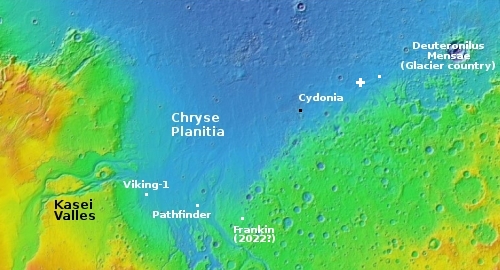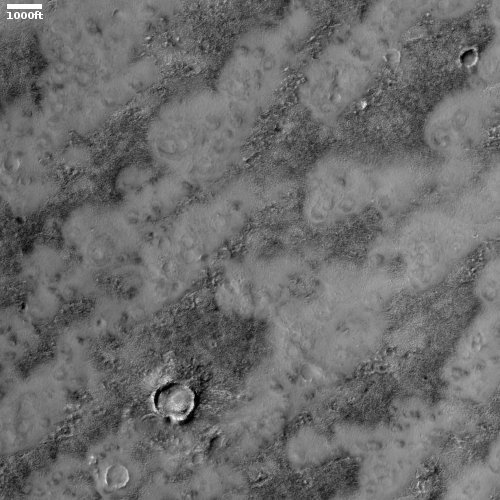More thumbprints on Mars!
Cool image time! Among the many strange and unexplained geological features that scientists have identified on Mars, the thumbprint feature is one of the most intriguing. The photo to the right, cropped and reduced to post here, is a fine example, and was taken on September 10, 2021 by the high resolution camera on Mars Reconnaissance Orbiter (MRO).
The thumbprints are the lighter splotches, and are generally found near curved ridges located mostly in Martian lowlands. All appear to have crater-like features in them, though these craters are not impact craters, but likely (though not confirmed) caused by some form of underground eruption, be it mud, ice, lava or something else. Though scientists do not yet really understand the process that formed the thumbprints, the data strongly suggests that they formed in connection with glacial events. From this 2003 paper [pdf]:
TT [thumbprint terrain] as well as the associated trough systems were formed by a glacial mechanism. [Elevation] data show that the trough systems consistently lie topographically above the TT; this implies that if they were they formed by the same glacier, the troughs must have formed before the glacier retreated and formed the TT.
The splash apron around the crater near the bottom of the photo supports the glacial theory, implying the presence here of underground ice.
Scientists have also theorized wind processes and cinder cones as explanations for these features.
These particular thumbprints are located, as shown in the overview map below, in the same general area as a previous cool image of thumbprints, from April 2019.

The white cross marks the location of today’s cool image, while the white dot marks the location of the April 2019 cool image. The black dot indicates the location of the mesa I dub the “non-face on Mars.”
Essentially, the data suggests that the thumbprints lie at the edge of what were once vast ice sheets. The curved ridges (called “troughs” for some reason by the scientists) might mark moraines, with the thumbprints lying under the glacier foot.
None of this is confirmed. Moreover, these hypothesises are based on comparing these features with similar Earth features, a useful but very dangerous method for explaining what we see on Mars. Mars is not Earth, and though the geology can have similarities, in the end it will form by its own very unique circumstances.
On Christmas Eve 1968 three Americans became the first humans to visit another world. What they did to celebrate was unexpected and profound, and will be remembered throughout all human history. Genesis: the Story of Apollo 8, Robert Zimmerman's classic history of humanity's first journey to another world, tells that story, and it is now available as both an ebook and an audiobook, both with a foreword by Valerie Anders and a new introduction by Robert Zimmerman.
The print edition can be purchased at Amazon or from any other book seller. If you want an autographed copy the price is $60 for the hardback and $45 for the paperback, plus $8 shipping for each. Go here for purchasing details. The ebook is available everywhere for $5.99 (before discount) at amazon, or direct from my ebook publisher, ebookit. If you buy it from ebookit you don't support the big tech companies and the author gets a bigger cut much sooner.
The audiobook is also available at all these vendors, and is also free with a 30-day trial membership to Audible.
"Not simply about one mission, [Genesis] is also the history of America's quest for the moon... Zimmerman has done a masterful job of tying disparate events together into a solid account of one of America's greatest human triumphs."--San Antonio Express-News
Cool image time! Among the many strange and unexplained geological features that scientists have identified on Mars, the thumbprint feature is one of the most intriguing. The photo to the right, cropped and reduced to post here, is a fine example, and was taken on September 10, 2021 by the high resolution camera on Mars Reconnaissance Orbiter (MRO).
The thumbprints are the lighter splotches, and are generally found near curved ridges located mostly in Martian lowlands. All appear to have crater-like features in them, though these craters are not impact craters, but likely (though not confirmed) caused by some form of underground eruption, be it mud, ice, lava or something else. Though scientists do not yet really understand the process that formed the thumbprints, the data strongly suggests that they formed in connection with glacial events. From this 2003 paper [pdf]:
TT [thumbprint terrain] as well as the associated trough systems were formed by a glacial mechanism. [Elevation] data show that the trough systems consistently lie topographically above the TT; this implies that if they were they formed by the same glacier, the troughs must have formed before the glacier retreated and formed the TT.
The splash apron around the crater near the bottom of the photo supports the glacial theory, implying the presence here of underground ice.
Scientists have also theorized wind processes and cinder cones as explanations for these features.
These particular thumbprints are located, as shown in the overview map below, in the same general area as a previous cool image of thumbprints, from April 2019.

The white cross marks the location of today’s cool image, while the white dot marks the location of the April 2019 cool image. The black dot indicates the location of the mesa I dub the “non-face on Mars.”
Essentially, the data suggests that the thumbprints lie at the edge of what were once vast ice sheets. The curved ridges (called “troughs” for some reason by the scientists) might mark moraines, with the thumbprints lying under the glacier foot.
None of this is confirmed. Moreover, these hypothesises are based on comparing these features with similar Earth features, a useful but very dangerous method for explaining what we see on Mars. Mars is not Earth, and though the geology can have similarities, in the end it will form by its own very unique circumstances.
On Christmas Eve 1968 three Americans became the first humans to visit another world. What they did to celebrate was unexpected and profound, and will be remembered throughout all human history. Genesis: the Story of Apollo 8, Robert Zimmerman's classic history of humanity's first journey to another world, tells that story, and it is now available as both an ebook and an audiobook, both with a foreword by Valerie Anders and a new introduction by Robert Zimmerman.
The print edition can be purchased at Amazon or from any other book seller. If you want an autographed copy the price is $60 for the hardback and $45 for the paperback, plus $8 shipping for each. Go here for purchasing details. The ebook is available everywhere for $5.99 (before discount) at amazon, or direct from my ebook publisher, ebookit. If you buy it from ebookit you don't support the big tech companies and the author gets a bigger cut much sooner.
The audiobook is also available at all these vendors, and is also free with a 30-day trial membership to Audible.
"Not simply about one mission, [Genesis] is also the history of America's quest for the moon... Zimmerman has done a masterful job of tying disparate events together into a solid account of one of America's greatest human triumphs."--San Antonio Express-News



When you blow this up, the area between the thumbprints is full of tiny holes all about the same size and spacing. Reminds me of a certain type of coral head skeleton. Mars is weird. I hope someday humans get to figure it all out.